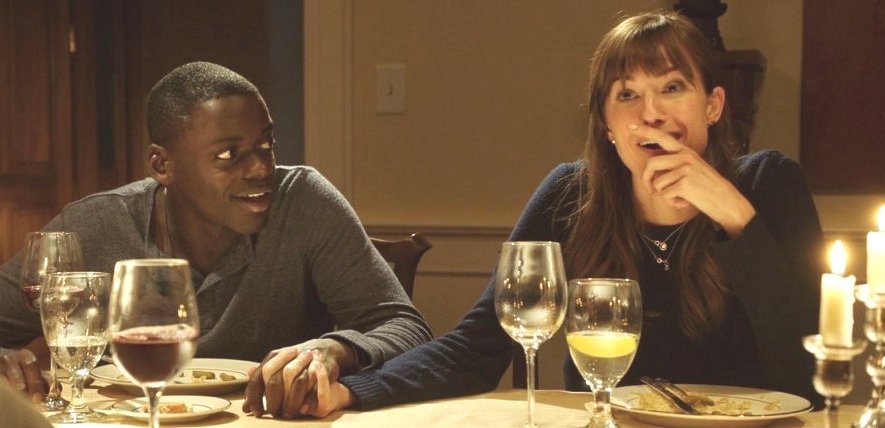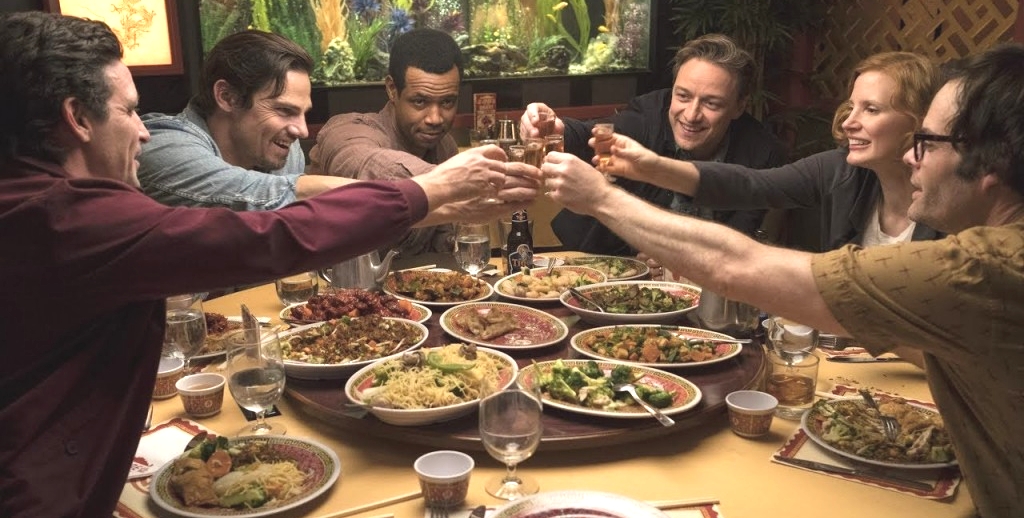Horror is a very useful genre. No, really. Even the campiest B-productions, the gorefests, and early aughts parodies have something to teach us. About the root causes of our insomnia. About childhood traumas we have yet to fully explore. About our internal moral compass and the very specific level of inhumane treatment we can watch others suffer through. It can also introduce us to new fears and phobias we had no clue were lurking under our hollow shell of functioning adulthood. Mundane things, like crowds or clowns, basements, and bathtubs. Horror knows what frightens us, sometimes better than we know ourselves which is why, during this holiest of months for fans of the genre, we’re digging into one of the most chilling tropes that seems to pop up in every on-screen fright fest: the sit-down dinner scene.
Horror has understood how bizarrely masochistic our human ritual of eating together is, long before anyone was using their self-diagnosis of social anxiety to skip out on family get-togethers and Friendsgivings. Inescapable exercises in formal etiquette, the consumption of a meal someone else has prepared, the life-draining amount of small-talk necessary to survive – the dinner table truly is The Hunger Games of horror, a gladiator-esque arena where people live and die by how well they play the game.
What that game is depends mainly on who you’re dining with. Is it your significant other’s parents? Then the game is making a good first impression. Is it your extended family? Then the game is making it out without wading into a political debate with your insufferable uncle. There are all kinds of games we play at the dinner table, performances we put on so that we can fill a basic need without cutting to the meat of our psychological hang-ups. We all inherently understand how to behave during these social ceremonies, which is why watching them play out in horror movies is so damn unsettling.

In Get Out, Jordan Peele prefers staging some of the film’s most unnerving scenes around the dinner table. Whether that’s a parental interrogation over afternoon tea or a more formal verbal sparring match at the family’s formal place-setting, Peele channels the eerie calm before the storm over a five-course meal. Chris (Daniel Kaluuya) has been welcomed into the Armitage family too easily, something that discomforts both him and the audience, but his combative interaction with Rose’s brother Jeremy (Caleb Landry Jones) builds the tension to intolerable heights. As they debate MMA fighting techniques and Jeremy creepily appreciates Chris’s build and “genetic makeup,” Peele makes sure to linger on the rest of the family’s reactions, how they fidget and glance and squirm as these two men go at it. Chris is held hostage by a construct of civility throughout the film – he has plenty of uncomfortable interactions that would warrant his escape but he stays out of politeness and an ingrained sense of courtesy he’s been taught to extend to white people – and that inability to leave is magnified in this scene, slowly turning what should be an awkwardly-average rite of passage into something more sinister. It’s that ability to take something so routine and make it this bloodcurdling event that elevates other psychological horror films too.
Ari Aster has mastered it, first with his familial exercise in grief around the dinner table in Hereditary. Free of pyrotechnics and seances, the fairly normal meal reeks of the dysfunction and demonic possession to come. Annie (Toni Collette) quietly seethes, picking at her food while her husband and son, Peter (Alex Wolff) look on nervously. Peter can’t ignore the tension which leads to Annie delivering a terrifying monologue. Possessed by rage and bitterness, she blames her son for her daughter’s death and dredges up hurtful memories, hurling them at both men as her face contorts in unnatural ways. It’s another way horror often uses the communal act to tease hidden truths and buried secrets and Aster makes us writhe in our seats with the hair-raising dread he elicits in this scene.
And if the psychology of sitting down with strangers and family members to a nice meal isn’t your particular brand of nightmare fuel, don’t worry: the dinner scene serves a dual purpose. Because as unsettling as the social dynamics are, what’s physically on the table often adds another element to this edible hellscape.
The most obviously horrific items on the menu fit the cannibalistic diet. In Ridley Scott’s Hannibal, the film ends with a stomach-churning scene that uses a bit of dark humor and a certain part of the human anatomy to play up the repulsiveness of its villain’s eating habits. While Julianne Moore’s Clarice sits paralyzed at the dinner table, Anthony Hopkins’ serial killer carefully cuts into the brain of Paul Krendler (Ray Liotta), peeling back the organ’s sack and carving a piece of his frontal lobe – the part of the brain that controls manners, ironically enough – before frying it and feeding it to the guy. Scott makes sure to engage the senses in this scene, forcing us to listen to the sawing of bone, the squish of organic material being manipulated, and the sizzle of Paul’s brain matter in the pan. And Lecter almost normalizes the whole interaction, describing it’s appetizing scent and unique taste in such a bleakly funny way that you’re left confused as to whether the whole meal is comedically surreal or disturbingly wrong.
Tobe Hooper was able to do something similar with The Texas Chainsaw Massacre, though his pound of human flesh came with more screams as Sally is surrounded by her psychotic dinner mates who prefer her fingers as appetizers. Park Chan-wook used his neo-noir action thriller Oldboy as a piece of subversive commentary on the evils of junk food with his live-octopus eating scene. Squiggling tentacles and lifeless appendages are nauseating on their own, but when served on a platter with serial killers, deranged animals, and revenge-driven ex-convicts, they leave an even more upsetting aftertaste.
But the horror in a good dinner scene doesn’t have to rely on threatening undertones or revolting delicacies. Sometimes, a meal can turn into a nightmare with a good bait-and-switch.

It Chapter Two did this fairly well when it gathered the old crew from Derry together for a Chinese dinner decades after they’d defeated Pennywise and forgotten the horrors of their small-town upbringing. The group reminisces on happier times, laughing at Bill Hader’s wise-cracking Richie and ribbing Ben’s recent weight-loss, ignoring the looming specter in the room, the supernatural reason why they can’t seem to recall important details about their shared pasts. It’s that sinister mystery that eventually corrupts the very food they eat, turning their joy into something dark and twisted before we have enough time to realize it.
And Aster perfected this illusion of safety when it comes to terrifying dinner scenes with his most recent work, Midsommar. Whether you view the film as an allegory about travel and colonialism, or a metaphor for toxic relationships and the corrosive nature of grief, the movie’s many feasts, all held outdoors in a blindingly bright atmosphere surrounded by beauty and nature, are some of the darkest moments of this thriller. Aster manages to use Pinterest-worthy place settings and cottage-core cult costumes to evoke a sense of calm and purity. The people have strange customs, but they’re welcoming and innocent-seeming. The food isn’t great but it’s being offered freely. It isn’t until we learn of a demented romance ritual that involves placing pubic hair in pie and menstrual blood in a glass of juice that we understand the darkness lurking in this idyllic setting.
Eating, the act of consuming something that used to be alive, is a naturally barbaric thing. We dress it up with silverware and cocktails and social rituals to make it less so. Why these kinds of scenes, whether they take place around a family’s dinner table or a cult’s outdoor feast, succeed in traumatizing us feels less concrete. Maybe it’s a combination of social anxieties and squeamish stomachs. Maybe it’s the constraint of that specific setting, the tension laying ripe on the placemat, the unspeakable truths traded over a meal when there’s nothing else to distract us from reality. Who knows? What is clear is that horror knows, and it’s starting to perfect the art of turning dinnertime into our worst nightmare.







